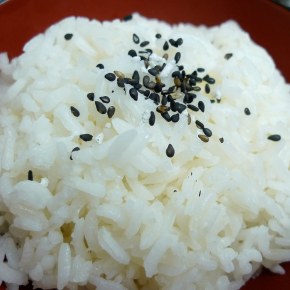Ever contemplated if the coffee grounds you’re about to toss away could be put to better use? Quite a number of scientists have, with proposed uses in fields ranging from bioenergy to food and pharmaceutical industries [1-3]. Some proposals involve recovering a chemical of interest from the coffee grounds, but a collaboration among researchers in … Continue reading
Author Archives: Alice Chi Phung
Green Tea
With origins in China dating back to over 4,000 years ago, green tea stands as the world’s oldest plant-based drink. It may very well also be the most chemically complex. With over 600 identified aroma compounds, the actual flavor of your cup of green tea depends on where the tea leaves (Camellia sinensis) were grown, … Continue reading
Aquafaba Meringues
Dr. Kent Kirshenbaum flew from NYC to LA to speak at our March 8th public lecture about the impact of what we eat, sharing the stage with Dr. Amy Rowat, Dr. Paul Thompson, and Chef Daniel Patterson. Impressively he brought along with him a case of hundreds of homemade vegan meringues for lecture attendees to nosh on … Continue reading
Aquafaba & Other Hopes for Delicious Egg-free Meringues
Meringues are one of the few desserts that are simple yet elegant works of art. They are also precursors to other impressive, albeit considerably more complicated, desserts such as baked Alaska, lemon meringue pies, and macarons. At the bare minimum, all you need to make a fluffy meringue is egg whites, sugar, and an electric … Continue reading
Black Sesame Seeds on Heavy Metal Cleanup
Heavy metals, such as cadmium, lead, and mercury, leach into our food supply through the air and water; these undesirable additives come from industrial processes such as mining, smelting, battery manufacture, electroplating, and pesticide production. Cadmium and lead are the chief contaminants of rice, wheat, and foods containing these cereals [1]. Mercury is often found … Continue reading
Cranberry
Cranberries are harvested in late autumn, just in time to celebrate the holidays. Whether you prefer to enjoy cranberries in a jam, as a sauce from the can, juiced, dried, or fresh, there’s no denying that cranberries are festive. They’re tart, dark red, and pair really well with a turkey dinner (according to science). Continue reading
Kombucha Brewing: The Process
At first glance, making kombucha sounds straightforward. After all, kombucha is fermented tea, which tells all you need to know about making it: take some tea and ferment it. Unfortunately, brewing kombucha is not that simple, as evidenced by the plethora of information and recipes found on the Internet. For those who have ever contemplated … Continue reading
Kombucha Brewing: The Ingredients
Craving some kombucha without the grocery store prices? Why not try brewing your own kombucha? As a fermented tea drink that is brightly effervescent, deliciously tangy, and slightly sweet, having some kombucha on hand could add a little spring to these cold seasons. On top of that, the brewing and fermentation involved in kombucha-making requires … Continue reading
Nutmeg
Nutmeg is a key note in October comfort favorites such as pumpkin spice lattes and spiced bread. The spice is warm, sweet, and spicy, perfect for the gradually colder days of autumn. Take a closer look at nutmeg, however, and you might find a disquieting surprise. Are you prepared to take a whiff of nutmeg … Continue reading
Cotton Candy
Summer would be incomplete without carnivals and bright, fleecy, sugary cotton candy. For a snack that’s nothing but sugar and air, there’s a surprising amount of physics and chemistry involved. Below are seven science-heavy facts about this feathery-light confection. Editor’s note: The original post stated that 1 ounce of cotton candy is 0.105 kilocalories, when in … Continue reading









